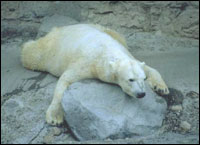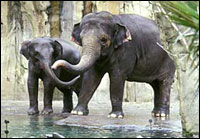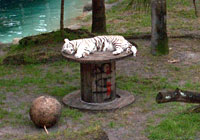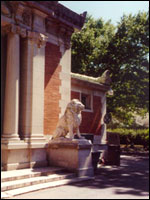Is it better to compost elephant dung or tap its energy with a methane generator? Will a ring-tailed lemur feel at home under energy-efficient lights?

Sustainability at zoos is a tall order.
The Wildlife Conservation Society, which runs New York City’s zoos and aquarium, is increasingly turning its attention to these and other environmental quandaries. In addition to managing what it describes as the largest urban wildlife park system in the world, the Bronx Zoo-based WCS, formerly the New York Zoological Society, is a major international conservation group with extensive research and education programs. Having recently dodged a budgetary bullet from the city government that might have put an end to the Brooklyn and Queens zoos, WCS is in the midst of revising its master plan for the first time since the 1960s, with the goal of incorporating sustainable practices throughout its facilities.
“We spend a lot of money overseas working toward wildlife conservation, and if we’re going to do that, we had better be living our mission at home,” says Sue Chin, director of planning and design for WCS.
Such eco-friendly concerns may not top the agenda at most zoos and aquariums, where attendance usually trumps sustainability in the hierarchy of goals. Still, the industry’s main trade group, the American Zoo and Aquarium Association (AZA), is promoting ecological responsibility, and WCS and other zoo operators are putting the theory into practice.
How Do You Zoo?
Among environmentalists, zoos have always generated, at best, mixed reactions; for some, they are synonymous with cruelty and imprisonment, while others see them as progressive outposts of research and conservation. In reality, it’s tough to generalize about zoos and aquariums, since they run the gamut from unlicensed roadside menageries to professionally staffed institutions with international conservation programs and education divisions. But whatever their role in society, zoos encompass major operations with considerable resource needs and often sprawling campuses. They may or may not preach ecological awareness, but their ecological footprints are substantial.
Through its Animal and Plant Health Inspection Service, the U.S. Department of Agriculture licenses zoos, aquariums, and other animal exhibitors — around 2,500 at present. The AZA claims to have more stringent criteria than APHIS in the areas of animal welfare, conservation, professional conduct, ethics, and education; it currently counts 212 North American institutions as members.
While the AZA members represent just a fraction of all animal operations in North America, they collectively occupy a sizeable chunk of real estate and do a high volume of business, with last year’s attendance at their facilities topping 134 million visitors. Member organizations typically sit on dozens (and sometimes hundreds or thousands) of developed acres; annual operating budgets can exceed $100 million. Although 85 percent are nonprofit, AZA institutions are big business.

Can she bear it?
The AZA may represent a step up from basic zoo licensing, but groups like the Humane Society charge that even some of the AZA’s more progressive members maintain outdated and unhealthy facilities. “There are some facilities doing some fairly innovative things, and we don’t want to discourage them,” says Richard Farinato, director of the captive wild animal protection program for the Humane Society of the United States. But at same time, he notes, there are notable lapses in animal care, including an incident earlier this year in which two endangered red pandas at Washington, D.C.’s National Zoo were accidentally poisoned with rat bait. Yet even in high-profile cases like that one, institutions can be slow to reform, according to Farinato. “They’ve done lots on paper, shuffled people around, assembled a commission from the National Academy of Sciences to examine the situation, but so far, they’ve just paid lip service to the problems,” he says.
Farinato also argues that zoos’ definition of animal welfare needs to be expanded. “To them, it means a clean cage and a good diet, but those are just the minimum responsibilities. An animal’s welfare also means its psychological well-being, choices, and the ability to express itself in a species-appropriate way,” he says. “Then you get into the question of which animals are not suited to captivity. The issue is quite large.”
And if zoos’ treatment of animals has been uneven, as a group their environmental practices have historically been even less impressive.
“You can’t overlook the impact of your institution and staff on the local environment,” says Christine Sheppard, curator of ornithology and green team leader at the Bronx Zoo. “You can’t just think about your animals, but zoos did.”
In recent years, though, there have been signs of change, from water conservation practices to renewable energy use to green building design. In a 2001 AZA member survey, about 40 percent of institutions reported composting, 40 percent said they had environmentally sensitive procurement policies, and 11 percent said they treated gray water onsite.

Environmentalism: the elephant in the living room.
Photo: Oregon Zoo.
Regional differences in environmental politics can dictate the pace of change, according to Sheppard. Some zoos — notably those in Toronto and Portland, Ore. — have “absolutely tremendous” environmental programs, she says, while others are resistant to change and worried about the bottom line: “You’re starting to see things happen within the context of local environmentalism. The more the local communities are involved in [the environmental movement], like in California and Oregon, the easier it is, versus the middle of Texas.”
But the AZA has thus far called only for voluntary sustainability efforts, so progress “all depends on the personality of the person running the institution and his or her point of view,” Farinato says. On the whole, serious environmentalism is “more an exception than the norm with zoos around the country, but the AZA tends to make it look like all zoos that are accredited are behaving like this,” he says.
Getting Down to Business
How do you go about making a zoo greener? Not all that differently than you would any other business or institution, according to Barbara Batshalom, executive director of the Green Roundtable, a sustainable-development advocacy group and Boston affiliate of the U.S. Green Building Council. The process is familiar: conserve energy, use renewable and clean power, decrease water consumption, reuse gray water, reduce and recycle solid waste, cut the use of harmful chemicals, buy sustainably produced materials and food, use mass transit, practice less destructive landscaping, and educate your employees and the general public about sustainability issues.

Go get ’em, tiger!
Of course, some considerations are zoo-specific. “If a critter needs some sort of animal enrichment item, you can think about using objects that might otherwise get thrown out,” says Chin of WCS. Curators at the Brookfield Zoo in Illinois used recycled tires to give the floor in their swamp exhibit a springy, bog-like feel, and they use hydropower to generate the surf crashing through the zoo’s coastal ecosystem display, according to Bill Torsberg, the zoo’s resource conservation coordinator.
Zoos have “a special advantage in that they’re a campus situation. They’re controlling a lot of worlds,” Batshalom says. “In some cases their procurement standards are higher than at schools. You can use arsenic-treated wood at schools, but not at zoos.”
There’s mounting interest in holding zoos accountable for their environmental practices. In addition to her work at the Bronx zoo, Sheppard chairs the AZA’s green practices scientific advisory group, which was formed last year. The group acts as a sustainability clearinghouse and is pushing for more emphasis on environmentalism in the accreditation process. (Zoo accreditation is reviewed every five years.) Over the last several years, accreditation reviewers have begun quizzing institutions on their environmental policies and programs, Sheppard says, though ecological issues are not yet make-or-break accreditation factors.
On many fronts, WCS is setting a high bar. Last spring, the WCS-managed New York Aquarium installed a 200-kilowatt hydrogen fuel cell to supply up to one-fifth of its daily electricity requirement, and, as a byproduct, heat water for some of its buildings and tanks. Even here, there is room for improvement, as the fuel cell is currently powered by natural gas. WCS is looking to add more fuel cells, and to use geothermal, wind, and solar energy where possible. The society has also committed to the expense and headache of continuing its recycling programs despite the withdrawal and phased-in return of New York City’s program, and it’s heading up efforts to restore the Bronx River watershed from Westchester County into the city.

The Bronx Zoo Lion House.
Photo: Fox & Fowle.
In addition, WCS is in the midst of some showcase green building projects. As the Bronx Zoo adapts its older buildings to current needs, it is doing so with an eye toward sustainability. For the past couple of decades, the 1903 Lion House, with a Beaux Arts exterior controlled by the city landmarks commission, sat unused; now it’s being renovated and is slated to reopen in 2006. The project architects, the appropriately named Fox & Fowle, designed the high-profile 4 Times Square Conde Nast building, among other green structures. The newly redone Lion House will qualify for the U.S. Green Building Council’s Leadership in Energy and Environmental Design certification.
Although its plans are ambitious in scope — especially given that they’re being hatched in the midst of a recession — WCS isn’t just pouring money into expensive statements of institutional concern for the biosphere. Many of the measures have both ecological and economic paybacks and are considered worthwhile investments, according to WCS officials.
It’s All Happening at the Zoo
In addition to improving its environmental infrastructure, WCS is calling attention to the ecological impact of human activities — especially local activities. “We can convince people that they need to help us in central Africa because gorillas are at risk, because we have the gorilla standing there and looking at you. That’s kind of an easy sell,” says Chin. “But how do we have people make that connection that actions here have an impact on the environment and on the world? People think about conservation as being a thing that needs to be done in other places. How do we connect them to here?”

Going ape for sustainability.
Sheppard echoes this sentiment, saying that visitors “don’t always understand that there are a lot of problems here. We educate them about rainforests, exotic pet collecting, hunting in South America, but [habitat] fragmentation is a problem here. One of our [current] exhibits has a wooden sign that says ‘For Sale: Adirondack Lots.'”
With this sharper focus on environmentalism at home, WCS and the Bronx Zoo have, in a sense, come full circle. At the turn of the last century, the zoo was among the most progressive in the nation, boasting naturalistic enclosures, the first full-time vet and first animal hospital at a U.S. zoo, and pioneering work in captive breeding. Later, the zoo began emphasizing international conservation and raising awareness of global issues. Now, they’re stressing their place in the local ecology.
Other zoos, including those in San Francisco, Seattle, and Syracuse, incorporate environmental awareness to some degree, but usually on a project-by-project basis. By choosing a different strategy — that is, by integrating green priorities into its master plan — WCS is likely to set the standard for zoos and similar institutions across the country and around the globe. Sheppard says WCS’s public embrace of sustainability, however imperfect, can invite serious change. She likens it to the species conservation movement in the 1970s: “I was part of the generation that started looking at conservation, even though zoos hadn’t really yet. There’s been a transformation in the last 25 years. Zoos [initially] thought it was a great idea for PR [but] it attracted people like me, and we … drove the whole organization in that direction.”
Now that zoos are moving toward sustainability as well as conservation, they can help move society at large in the same direction. “Zoos are in a position to teach their visitors what they want to teach them,” says the Humane Society’s Farinato.


